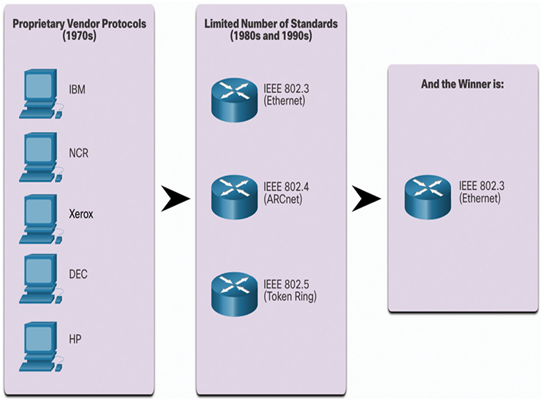Upon completion of this chapter, you will be able to answer the following questions:
• How do the OSI model Layer 1 and Layer 2 function in an Ethernet network?
• How do the Ethernet sublayers are related to the frame fields?
• What is the Ethernet MAC address?
• How does a switch build its MAC address table and forward frames?
This chapter uses the following key terms. You can find the definitions in the Glossary.
Institute of Electrical and Electronic Engineers (IEEE)
contention-based access method
Hey! It’s Webster again! Marcy and Vincent are beginning to see the value of Bob’s advice. But they can’t afford a lot of downtime and they need to operate with the existing network until Bob can make the upgrades. They will not add the VoIP, security cameras, or online ordering system until then. Bob needs to evaluate their existing network prior to the upgrade to better understand what will need to be done.
The furniture store’s network is an Ethernet network. Ethernet protocols define how data is formatted and how it is transmitted over the wired network and specifies protocols that operate at Layer 1 and Layer 2 of the OSI model.
Are you familiar with Ethernet? Why are the hexadecimal and binary number systems important in an Ethernet network? I think you should take this module to learn more about Ethernet, Ethernet frames, and Ethernet MAC addresses! Let’s get started!
When you are connecting to a network using a wired interface, you are using the Ethernet protocol. Even most wireless networks ultimately connect to a wired Ethernet network. Ethernet is an important data link layer protocol used in LANs (Local Area Networks) and most WANs (Wide Area Networks).
In the early days of networking, each vendor used its own proprietary methods of interconnecting network devices and networking protocols. If you bought equipment from different vendors, there was no guarantee that the equipment would work together. Equipment from one vendor might not communicate with equipment from another.
As networks became more widespread, standards were developed that defined rules by which network equipment from different vendors operated. Standards are beneficial to networking in many ways:
• Facilitate design
• Simplify product development
• Promote competition
• Provide consistent interconnections
• Facilitate training
• Provide more vendor choices for customers
There is no official local area networking standard protocol, but over time, one technology, Ethernet, has become more common than the others. Ethernet protocols define how data is formatted and how it is transmitted over the wired network. The Ethernet standards specify protocols that operate at Layer 1 and Layer 2 of the OSI model. Ethernet has become a de facto standard, which means that it is the technology used by almost all wired local area networks, as shown in Figure 21-1.

Figure 21-1 The Evolution from Proprietary LAN Protocols to Ethernet
The Institute of Electrical and Electronic Engineers, or IEEE (pronounced eye-triple-e), maintains the networking standards, including Ethernet and wireless standards. IEEE committees are responsible for approving and maintaining the standards for connections, media requirements and communications protocols. Each technology standard is assigned a number that refers to the committee that is responsible for approving and maintaining the standard. The committee responsible for the Ethernet standards is 802.3.
Since the creation of Ethernet in 1973, standards have evolved for specifying faster and more flexible versions of the technology. This ability for Ethernet to improve over time is one of the main reasons that it has become so popular. Each version of Ethernet has an associated standard. For example, 802.3 100BASE-T represents the 100 Megabit Ethernet using twisted-pair cable standards. The standard notation translates as:
• 100 is the speed in Mbps
• BASE stands for baseband transmission
• T stands for the type of cable, in this case, twisted-pair.
Early versions of Ethernet were relatively slow at 10 Mbps. The latest versions of Ethernet operate at 10 Gigabits per second and more. Imagine how much faster these new versions are than the original Ethernet networks.
Video – Ethernet Addressing (21.1.3)
Refer to the online course to view this video.
Lab – Determine the MAC Address of a Host (21.1.4)
In this lab, you will complete the following objectives:
• Determine the MAC address of a Windows computer on an Ethernet network using the ipconfig /all command.
• Analyze a MAC address to determine the manufacturer.
